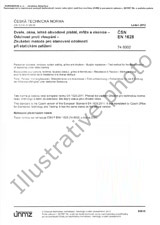We need your consent to use the individual data so that you can see information about your interests, among other things. Click "OK" to give your consent.
ČSN ETSI EN 300392-3-12-V1.2.1 (875042)
Terrestrial Trunked Radio (TETRA); Voice plus Data (V+D); Part 3: Interworking at the Inter-System Interface (ISI); Sub-part 12: Transport layer independent Additional Network Feature Individual Call (ANF-ISIIC)
Translate name
STANDARD published on 1.11.2020
The information about the standard:
Designation standards: ČSN ETSI EN 300392-3-12-V1.2.1
Classification mark: 875042
Catalog number: 510774
Publication date standards: 1.11.2020
SKU: NS-1008304
The number of pages: 120
Approximate weight : 391 g (0.86 lbs)
Country: Czech technical standard
Category: Technical standards ČSN
The category - similar standards:
Annotation of standard text ČSN ETSI EN 300392-3-12-V1.2.1 (875042):
V1.2.1
The present document defines the Terrestrial Trunked Radio (TETRA) system supporting Voice plus Data (V+D). It specifies:
- - the interworking of individual calls between TETRA networks;
- - the supplementary services interaction with individual calls between TETRA networks.
The TETRA V+D interworking - basic operation part defines the interworking between TETRA networks over the corresponding interface: the Inter-System Interface (ISI). It comprises the following sub-parts:
- - Transport layer independent General design [2];
- - General Design, PSS1 over E.1 [3];
- - General Design, SIP/IP [4];
- - Transport layer independent Additional Network Feature - ISI Individual Call (ANF-ISIIC) (the present document);
- - Transport layer independent Additional Network Feature - ISI Group Call (ANF-ISIGC) [5];
- - Transport layer independent Additional Network Feature - ISI Short Data service (ANF-ISISDS) [i.8];
- - Transport layer independent Additional Network Feature - ISI Mobility Management (ANF-ISIMM) [6];
- - Generic Speech Format Implementation [i.7].
The present document is the ANF-ISIIC sub-part.
Like all other Additional Network Feature (ANF) specifications, those of ANF-ISIIC are produced in three stages, according to the method described in Recommendation ITU-T I.130 [i.4]. The present document contains the stage 1 and 2 descriptions of ANF ISIIC, and stage 3 description. The stage 1 description specifies the ANF as seen by its users, which are essentially the individual call control entities in both TETRA networks. The stage 2 description identifies the functional entities involved in the ANF and the information flows between them. And the stage 3 description of ANF-ISIIC specifies its protocol.
NOTE 1: According to Recommendation ITU-T I.130 [i.4], the stage 3 description of a bearer or tele-service addresses the network implementation aspects. Consequently, it comprises two steps: the specifications of all protocols at the various reference points involved in any of the service procedures (notably the service operation) are the first step of the stage 3 description, and the specifications of the functions of the corresponding network entities are its second step.
NOTE 2: The SDL diagrams have not been provided since they can be derived from the specification of the functional entity actions in the stage 2 description.
The present document applies to TETRA networks which support inter-TETRA individual calls. More specifically, it applies to their Circuit Mode Control Entities (CMCE), as defined in clause 14.2 of ETSI EN 300 392-2 [1], and to their ANF-ISIIC entities defined in the stage 2 description.
The relation between the ANF-ISIIC and the transport layer protocol is described in the General Design documents [2], [3] and [4]
Preview of the standard ČSN ETSI EN 300392-3-12-V1.2.1 (875042)
We recommend:
Technical standards updating
Do you want to make sure you use only the valid technical standards?
We can offer you a solution which will provide you a monthly overview concerning the updating of standards which you use.
Would you like to know more? Look at this page.




 Cookies
Cookies
